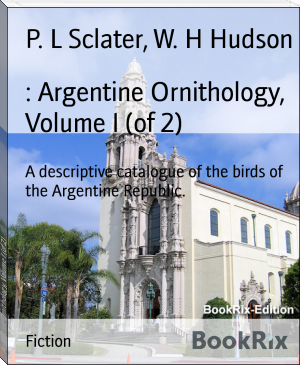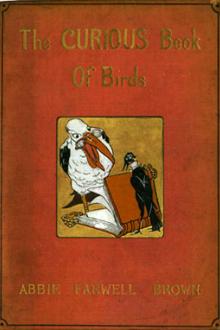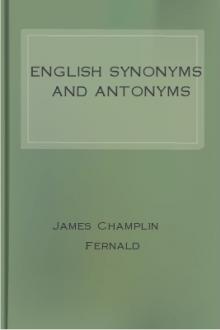: Argentine Ornithology, Volume I (of 2), P. L Sclater, W. H Hudson [best authors to read txt] 📗

- Author: P. L Sclater, W. H Hudson
Book online «: Argentine Ornithology, Volume I (of 2), P. L Sclater, W. H Hudson [best authors to read txt] 📗». Author P. L Sclater, W. H Hudson
1882, p. 594 (Buenos Ayres); _Döring, Exp. al Rio Negro, Zool._
37 (Azul); _Barrows, Bull. Nutt. Orn. Cl._ viii. p. 87(Concepcion, Entrerios); _Sharpe, Cat. B._ x. p. 610. +Anthus
rufus+, _Burm. La-Plata Reise_, ii. p. 474 (Mendoza, Paraná);
_Durnford, Ibis_, 1876, p. 158.
_Description._--Above pale sandy buff, mottled with black centres
to the feathers; wing- and tail-feathers dark brown, edged with
buff, the penultimate tail-feather with a white tip, the outer
tail-feather almost entirely white; neck and breast sandy buff, with
large triangular black spots; flanks buff, streaked with black;
abdomen and under tail-coverts isabelline; bill dusky grey; feet
pink: total length 6·0 inches, wing 2·9, tail 2·3. _Female_ similar.
_Hab._ Paraguay, Argentina, Patagonia, and Chili.
Azara's only reason for calling this bird _La Correndera_ was because he
thought it resembled a Tit-Lark known by that name in his own country,
but of which he merely had a confused recollection. It is therefore to
be regretted, I think, that _correndera_ has been adopted as a specific
name by naturalists instead of "Cachila," the vernacular name of the
bird, familiar to every one in the Argentine country. Azara's Spanish
bird was probably _Anthus pratensis_, which closely resembles _A.
correndera_ in general appearance, and has, moreover, as wide a range in
the northern as the last-named species has in the southern hemisphere.
In the volume on Birds in the 'Voyage of the Beagle,' it is said that a
species of _Anthus_ ranges further south than any other land-bird, being
the only land-bird found on Georgia and South Orkney (lat. 61° S.).
In colour and language, possibly also in size, the Cachila is variable.
It is a very common bird, widely and plentifully distributed over the
pampas, found alike on marshy and dry grounds, but rare in the region of
giant grasses. While abundant, it is also very evenly dispersed, each
bird spending its life on a very circumscribed plot of earth. Those
frequenting marshy or moist grounds are of a yellowish-cream colour,
thickly mottled and striped with fuscous and black, and have two narrow
parallel pure white marks on the back, very conspicuous when the bird is
on the ground. The individuals frequenting high and dry grounds are much
paler in hue, appearing almost grey, and do not show the white marks on
the back. They also look larger than the birds on marshy lands; but this
appearance is probably due to a looser plumage. The most strongly-marked
pale and dark-plumaged variations may be found living within a few
hundred yards of each other, showing how strictly each bird keeps to
its own little "beat"; for this difference in coloration is, no doubt,
due entirely to the amount of moisture in the ground they live on.
The Cachilas are resident, living in couples all the year round, the
sexes being faithful. Several pairs frequent a small area, and sometimes
they unite in a desultory flock; but these gatherings are not frequent.
In the evening, at all seasons, immediately after the sun has set, the
Cachilas all rise to a considerable height in the air and fly wildly
about, chirping for a few minutes, after which they retire to roost.
When approached they frequently rise up several feet from the ground and
flutter in the air, chirping sharply, with breast towards the intruder.
This is a habit also found in Synallaxine species inhabiting the grassy
plains. But, as a rule, the Cachilas are the tamest of feathered
creatures, and usually creep reluctantly away on their little pink
feet when approached. If the pedestrian is a stranger to their habits
they easily delude him into attempting their capture with his hat, so
little is their fear of man.
To sing, the Cachila mounts upwards almost vertically, making at
intervals a fluttering pause, accompanied with a few hurried notes. When
he has thus risen to a great height (but never beyond sight as Azara
says) he begins the descent slowly, the wings inclining upwards; and,
descending, he pours forth long impressive strains, each ending with a
falling inflection or with two or three short throat-notes as the bird
pauses fluttering in mid-air, and then renewed successively until, when
the singer is within 3 or 4 feet of the earth, without alighting he
reascends as before to continue the performance. It is a very charming
melody, and heard always on the treeless plains when there is no other
bird-music, with the exception of the trilling and grasshopper-like
notes of a few Synallaxine species. But in character it is utterly
unlike the song of the Sky-Lark with its boundless energy, hurry, and
abandon; and yet it is impossible not to think of the Sky-Lark when
describing the Cachila, which, in its manners, appearance, and in its
habit of soaring to a great height when singing, seems so like a small
copy of that bird.
The Cachila rears two broods in the year; the first is hatched about the
middle of August, that is, one to three months before the laying-season
of other Passerine species. By anticipating the breeding-season their
early nests escape the evil of parasitical eggs; but, on the other hand,
frosty nights and heavy rains are probably as fatal to as many early
broods as the instinct of the _Molothrus bonariensis_, or Cow-bird, is
to others at a later period.
The second brood is reared in December, the hottest month, and in that
season a large proportion of their nests contain parasitical eggs.
The nest is placed in a slight hollow in the ground, under a tussock of
grass, and is sometimes elaborately made and lined with horsehair and
fine grass, and sometimes with a few materials loosely put together.
During the solstitial heats I have frequently found nests with frail
shades, built of sticks and grass, over them, the short withered grass
affording an insufficient protection from the meridian sun. The eggs are
four, elongated, with a dirty white and sometimes a dull bluish ground,
thickly spotted with dusky brown and drab. In some eggs the spots are
confluent, the whole shell being of a dull brownish-drab colour.
The manners of this species, where I have observed it, are always the
same; it lives on the ground on open plains, where the herbage and grass
is short, and never perches on trees. The song varies considerably in
different districts.
16. ANTHUS FURCATUS, d'Orb. et Lafr. (FORKED-TAIL PIPIT.)
+Anthus furcatus+, _d'Orb. Voy._ p. 227 (Patagonia); _Darwin, Zool.
Voy. 'Beagle'_, iii. p. 85 (La Plata); _Sclater, Ibis_, 1878, p.
364; _Döring, Exp. al Rio Negro, Zool._ p. 37 (Azul,
Carhué-pampas); _Sharpe, Cat. B._ x. p. 605.
_Description._--Similar to _A. correndera_, but with a smaller bill,
shorter and more curved hind claw, less spotted under surface, and
different marking of the second outer rectrix, which has a clear and
distinct white line along the inner side of the shaft: total length
6·0 inches, wing 3·2, tail 2·4.
_Hab._ Peru, Bolivia, and Argentina.
One of the Pipits procured at Conchitas belongs to this species, if
distinct from the former. I think I recollect it as a resident on the
pampas, closely resembling the Cachila in flight and language, but much
shyer, and usually found concealed under Tulu grass on dry grounds.
Fam. VI. (MNIOTILTIDÆ, or WOOD-SINGERS.)
The Mniotiltidæ, or Wood-singers, are a well-known and very
characteristic family of the New World, where they occupy the position
of our Sylviidæ. They number some 130 or 140 species, distributed all
over America down to La Plata, but most abundant in the southern
portions of North America, where the favourite and beautiful genus
_Dendrœca_, with about 100 species, plays an important part. In
Argentina only four species have as yet been met with.
17. PARULA PITIAYUMI (Vieill.). (PITIAYUMI WOOD-SINGER.)
+Parula pitiayumi+, _Scl. et Salv. Nomencl._ p. 8; _Durnford, Ibis_,
1876, p. 158, 1877, p. 168 (Buenos Ayres); _Salv. Ibis_, 1880,
352 (Tucuman); _White, P. Z. S._ 1882, p. 594 (Catamarca,Misiones); _Barrows, Bull. Nutt. Orn. Cl._ viii. p. 87
(Concepcion, Entrerios); _Sharpe, Cat. B._ x. p. 259, pl. xi.
fig. 1. +Sylvicola venusta+, _Burm. La-Plata Reise_, ii. p. 473
(Paraná, Tucuman).
_Description._--Above clear blue; mantle and upper back olive-yellow;
central tail-feathers blue, all the others, also the quills,
blackish; cheeks and under surface of body bright yellow; lower
abdomen and under tail-coverts white; upper mandible black, lower
yellow; eye brown: total length 4·0 inches, wing 2·05, tail 1·55.
_Female_ similar, but much paler in colour.
_Hab._ South America.
This is a southern representative of a small group of Wood-warblers,
which is extensively diffused in the New World.
The upper plumage of this small bird is mostly cerulean-blue, the
breast and belly yellow. Its Guarani name, according to Azara, is
"_Pitiayume_," which means little yellow-breast. I have never heard
it sing or utter any note beyond a very feeble chirp as it hops about
through the foliage in quest of small caterpillars. Its migration
extends south to Buenos Ayres, where it is seen in woods and thickets
in pairs or singly; but it is a rare bird, and I have been unable to
find out anything about its nesting-habits.
18. GEOTHLYPIS VELATA (Vieill.). (VEILED WOOD-SINGER.)
+Geothlypis velata+, _Scl. et Salv. Nomencl._ p. 9; _White, P. Z. S._
1882, p. 594 (Salta); _Barrows, Bull. Nutt. Orn. Cl._ viii. p. 87
(Concepcion, Entrerios); _Sharpe, Cat. B._ x. p. 363, pl. ix.
fig. 5.
_Description._--Above yellowish green; the wing-coverts like
the back; wing-feathers dusky brown, edged with olive-yellow;
tail-feathers olive-green; crown of head to the occiput blue-grey;
from the forehead a black mark extends to the eye and downward to
the cheek; throat and under surface bright yellow; bill black; feet
pale brown; eye





Comments (0)